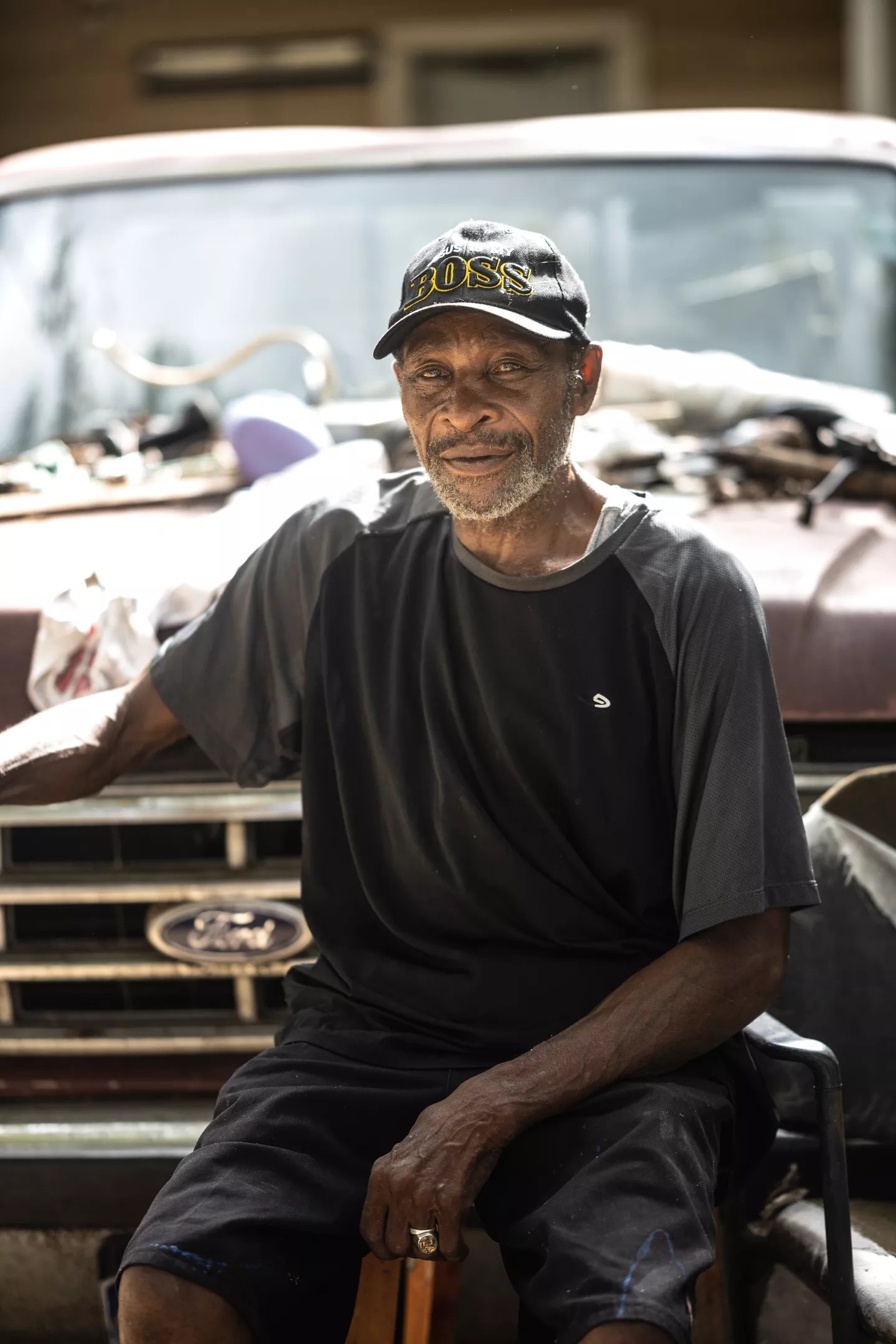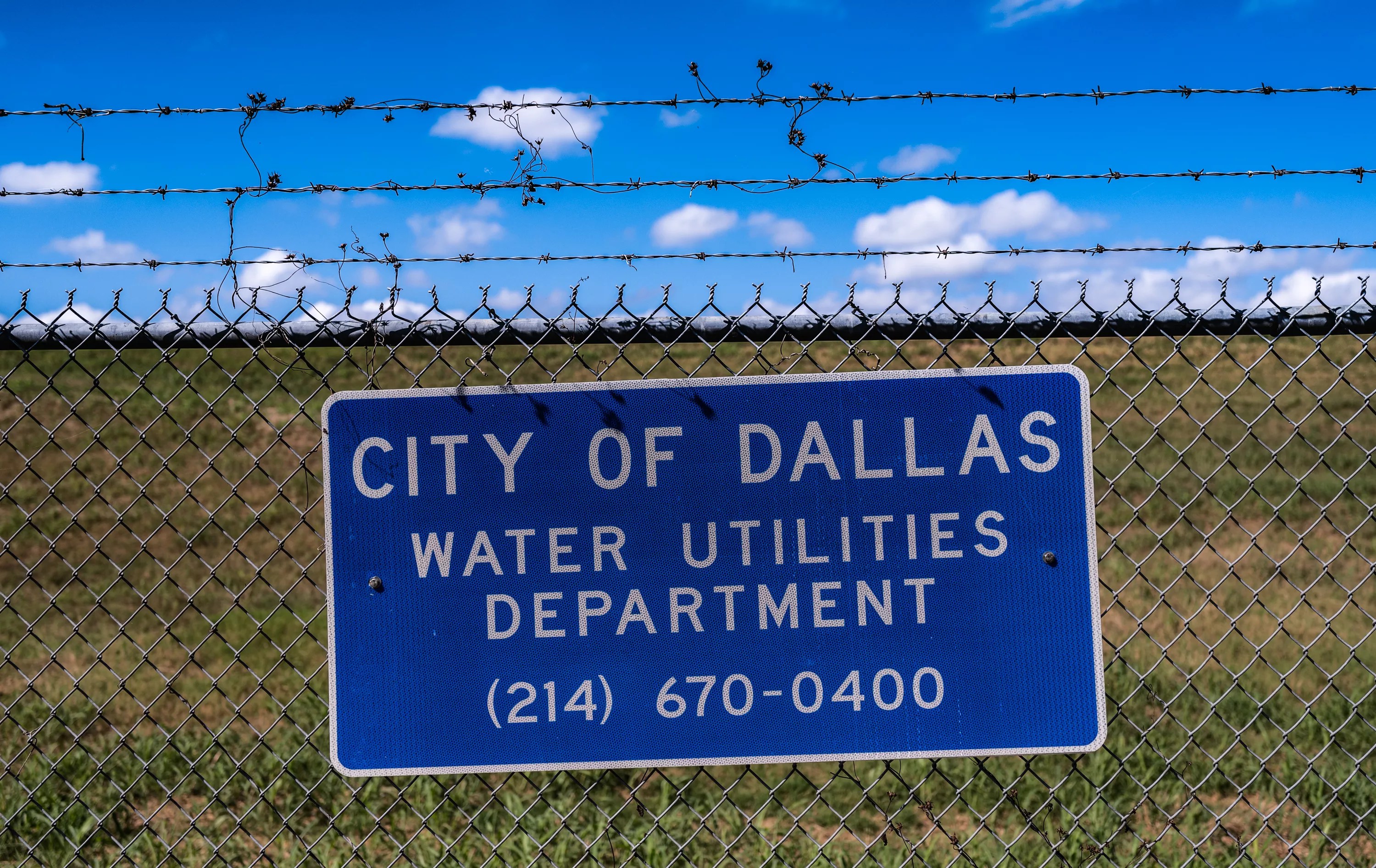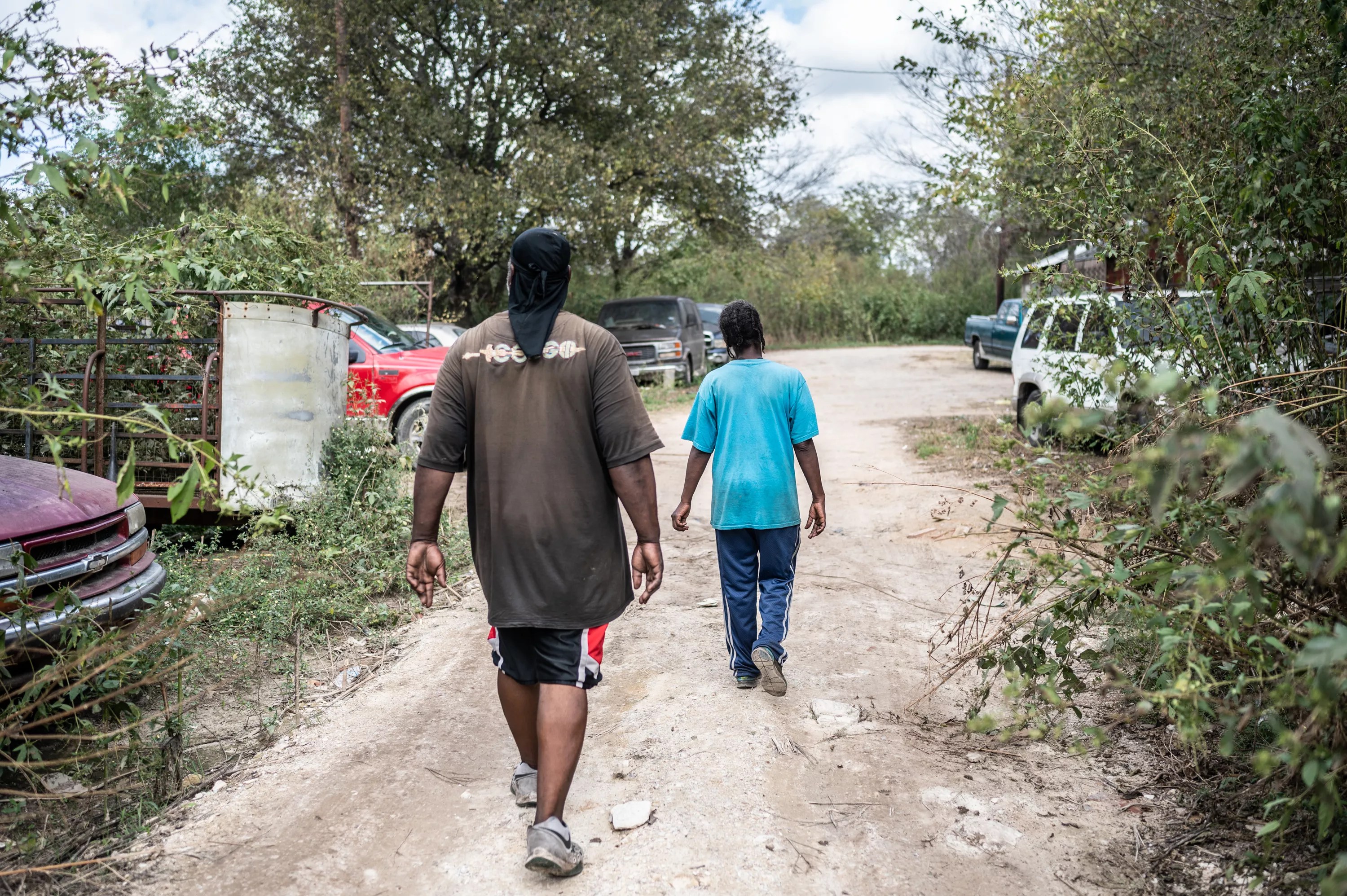
Mike Brooks

Audio By Carbonatix
Ricky Bryant sat outside his home just down the street from the Mt. Zion Missionary Baptist Church in Sandbranch, an unincorporated community off Belt Line Road in the southeast corner of Dallas County, where he has lived on and off since 1960.
Sandbranch was exciting back then, he said.
“We had houses everywhere, people everywhere,” Bryant said. “There were probably 200 or more down here then just in this little community. You had families on each street. Most of them had five or more kids.”
He moved back permanently in 2011 after his father died. Now, he said, “It’s lacking a lot.” Bryant walks over to a wooden structure. Inside, pipes are configured to pump water from the ground, through a filter and into his home. But the water isn’t clean enough to drink.
This year, make your gift count –
Invest in local news that matters.
Our work is funded by readers like you who make voluntary gifts because they value our work and want to see it continue. Make a contribution today to help us reach our $30,000 goal!
Sandbranch hasn’t had clean running water for more than three decades. It’s a former freedman’s town without pipes, sewerage, trash collection or street lights. While he would like to have clean water and other utilities, Bryant said he loves living in Sandbranch. Many residents feel this way.
They used to be able to drink from their wells, but over time, the water became discolored, tainted by sediment, and emitted a putrid smell. The community believes gravel mining in the area contaminated their water. Dallas County has suggested waste from livestock and residents is to blame for the nearly unusable water. Some say it’s probably a little of both.
The water started making people ill in the 1980s, so residents rely on donated bottles of water for drinking. Some residents there claim the well water is OK to drink. Others won’t even give it to their livestock. The Federal Emergency Management Agency (FEMA) said the community is in a floodplain, so Dallas County demolished Sandbranch homes that weren’t in compliance with flood regulations and paid to relocate the residents.
Homes built before Dallas County’s flood regulations were formed were allowed to stay, but this shrank the community to about 100 residents. John Wiley Price, the county commissioner for the area, has said he lost hope in providing water for Sandbranch, dismissing it as a bad investment given the small population and the fact that the community is in a floodplain.
Throughout the years, different groups have tried to help Sandbranch, and plenty still do. Water is periodically donated to the community. On Saturday mornings, produce is distributed at the church. However, many efforts to bring running water and other utilities to the neighborhood have fizzled away, mostly because it’s costly and complicated. But clean running water may be right around the corner for Sandbranch.
A red Ford F-150 pulled up on Burns Drive. Mahogany Nunnally was inside. She lives on private property near Sandbranch. She’s from Beaumont, Texas, but she came to the Dallas area after Hurricane Rita. She said some Sandbranch residents come down to her property to use her well.
At her property, the smell of cooked pork fills the air, masking the sour stench of several pig pens.
“We have a whole lot of pigs,” she said. “We sell some. We keep some. We cook them. We got a pig on the grill right now. We cook it for about 12 hours or more. We grow onions, jalapeños, tomatoes, different stuff.”
They use bottled water for most things, she said, but they sometimes have to bathe with the well water. The water is hard, she said.
Nunnally and her husband, Darwin Shipman, were hanging outside their trailer smoking cigarettes. Smoke from burning trash in a nearby fire pit wafted through the air. They’ve had the property for five years, but they’ve only lived on it for the last four.
“We just moved on down here because we’ve got our pigs and stuff down here,” Shipman said. “Might as well stay close to them so no one comes and steals them.” The two are raising a son who plays on the football team at Seagoville High School. They say he’s better than good. Shipman wants to build a house on their property, some place where they can spend the rest of their lives.

Mahogany Nunnally gathers water in barrels near her home in Sandbranch.
Mike Brooks
Ben Sandifer, a local environmental advocate, said Sandbranch is like the Rio Grande Valley along the border, where there are small communities of people who are disconnected from government support or utilities.
“Sandbranch is basically an inland colonia,” Sandifer said, referring to unincorporated, low-income areas along the U.S.-Mexico border that often lack potable water, paved roads, electricity and other utilities.
Sandifer’s specialty is in water and water testing, and he was curious about Sandbranch’s polluted aquifer.
He said many of the homes there were built and brought in from other places, like the South Dallas and Fair Park area. Homes that were set to be demolished in those neighborhoods were moved to Sandbranch.
When Sandbranch first formed, there weren’t many people or livestock on the property. To get water, they’d only have to dig about 15-20 feet by shovel to access the aquifer. That’s a good thing and a bad thing.
“The perched aquifer that’s there is easily accessible as a drinking water source, but it also easily allows in the contaminants in the soil,” Sandifer said.
“If you go drive through Sandbranch, you’ll see a lot of people that raise livestock – chickens, hogs, cows and horses – and their excrement filters down into the perched aquifer there, this real shallow aquifer, and the aquifer’s now contaminated.”
Some of the contamination could come from sources outside of Sandbranch, like gravel mining operations or junkyards in the area, Sandifer said.
“There are other chemicals, I imagine, that are in the water,” Sandifer said. “There’s a sulfury or rotten-egg smell to the water. There’s probably more than just surface pollutants from animal livestock that are now in that aquifer.”
Either way, the land is damaged, he said. One good step to heal it would be to find better ways to dispose of human and animal waste that might be polluting the aquifer. But Sandifer doesn’t know how likely that is.
“That’s a lifestyle,” he said. “It’s a way of life for people in that neighborhood and it wouldn’t be as much of an issue health wise if they had clean drinking water from a municipal water supply.”
Sandifer said, “I think at some point in the past, the last hundred years, we’ve gone from clean water being a privilege to a right. I think clean water is a right for all Texans, something that every Texan who lives in a home should be afforded by their local and county government.”

Ricky Bryant sits up against a truck outside his home in Sandbranch.
Mike Brooks
A lot of momentum was built in the community by the church’s former pastor Eugene Keahey, who died in 2019. Keahey went to Sandbranch to lead the Mt. Zion Missionary Baptist Church in 2010. Six years later, when national attention was on the water crisis in Flint, Michigan, Keahey got Sandbranch in the public eye. Around that time, in 2016, the Sandbranch Development and Water Supply Corp. was created to help bring water infrastructure to the neighborhood. It’s a volunteer group that meets regularly to plan and organize enough funds to bring water and waste water services to Sandbranch.
There was an Environmental Protection Agency Region 6 think tank session in Dallas around that time, involving people from all over Texas, Louisiana, Oklahoma and New Mexico, Sandifer said.
“So, you had African Americans who dealt with hurricanes on the Gulf Coast and you had Native Americans on Navajo reservations out in New Mexico. You had people that were dealing with chicken farm pollution in Arkansas,” Sandifer explained. “The whole gambit. The whole wide swath of it.”
One of the keynote speakers for that think tank session was Keahey.
Around this time was when attorney Mark McPherson met Keahey. McPherson is an environmental attorney who now represents the church.
McPherson originally got involved in Sandbranch when he was a member of the Christ United Methodist Church in Plano. He found out his church was donating a hundred water coolers to Sandbranch and he ended up helping to bring them down there. This is when he met Keahey.
The pastor told McPherson that 11 heads of governmental agencies would be coming to Sandbranch. “Boots on the ground, all at the same time,” McPherson explained. Keahey invited McPherson and whoever else wanted to tag along on the day these officials would be visiting.
“My curiosity was piqued, much like it was when I first heard about Sandbranch,” McPherson said. “The whole idea that there was an area that close to downtown Dallas that’s basically a colonia, it just blew my mind. I just couldn’t fathom that, so I had to see it. Then all these government agencies are coming in. Well, I had to see that too.”

A gate surrounds the Dallas Southside Wastewater Treatment Plant near Sandbranch.
Mike Brooks
Keahey fought with the city, the county and FEMA trying to bring water to Sandbranch. Then, in 2019, Keahey, his wife and two daughters were found dead after a fire at their home. Keahey’s death was ruled a suicide by gunshot. His wife’s and daughters’ deaths were ruled homicides.
There are still reminders of Keahey in Sandbranch, like a sign on a chain-link fence near the church advertising a community garden coming soon. This was one of Keahey’s ideas, McPherson said. He wanted to build community gardens in the deepest part of the floodplain, hoping it could eventually bring food and jobs to the community.
A lot of momentum for change in Sandbranch died with Keahey.
Still, the community has been quietly getting closer to one day having clean running water. McPherson and others are still determined to help make that happen.
The Sandbranch Development and Water Supply Corp. put out this statement after Keahey died: “We haven’t given up on Sandbranch, and neither should you. Pastor Keahey’s dream is still alive, and, with your support and cooperation, we’ll continue fighting to make it a reality. It won’t happen overnight, but it will happen.”
McPherson offered his services pro bono and has been working with the community ever since.
Eventually, McPherson realized that the government isn’t equipped to handle such a complicated problem as bringing water to Sandbranch – not alone at least. So, they moved forward with the Sandbranch Development and Water Supply Corp.
Since then, the U.S. Department of Agriculture has gotten involved and committed to extend a grant of up to 75% of the cost of the system, McPherson said. The agency also paid $30,000 to commission an engineering study to evaluate the most efficient way to bring water to Sandbranch.
The best way, they found, was to contract with Dallas Water Utilities to buy treated water wholesale and purchase waste water treatment services. They would build a supply line from the plant into Sandbranch and have sewer lines run right back to the plant. “The estimated cost on that system came back at $6.5 million,” McPherson said. “Water and sewer is one of, if not the most expensive part of development.”

Darwin Shipman (right) and Mahogany Nunnally walk around their property in a part of Sandbranch people call the bottoms.
Mike Brooks
Then, they set out to find the money for the remaining 25%. They applied for grants from the Texas Water Development Board and eventually closed on a $450,000 grant in December 2020 for planning, acquisition and design. That’s what they’re working on right now. They’re also trying to make sure the system is financially viable through different plans.
Once they get through the acquisition and design stage, they’ll go back to the Texas Water Development Board and the USDA for more grants for construction.
It’s a lot of work, but McPherson said he and the Sandbranch Development & Water Supply Corporation are slowly chipping away at it.
One thing is certain, though, he’s done playing the blame game. He didn’t want to make this about what residents could do to clean up the aquifer. He didn’t want to go after anyone with lawsuits. All he wanted to focus on was getting the water.
“That’s one of those things that we decided early on as a matter of strategy: We’re not going to point the blame at anybody,” McPherson said. “Because we want to work in a collaborative way. We want to partner with people.”
“We don’t want this to become a blame game because what happens when you start doing that is everybody freezes,” he said. “They stop. They stop cooperating. They stop helping, and that delays what is so desperately needed in Sandbranch. We’re just going to say, ‘It happened. We don’t know how it happened. At this point, we just don’t care because the most important thing today is to bring water and sewer to this community ASAP, period.'”